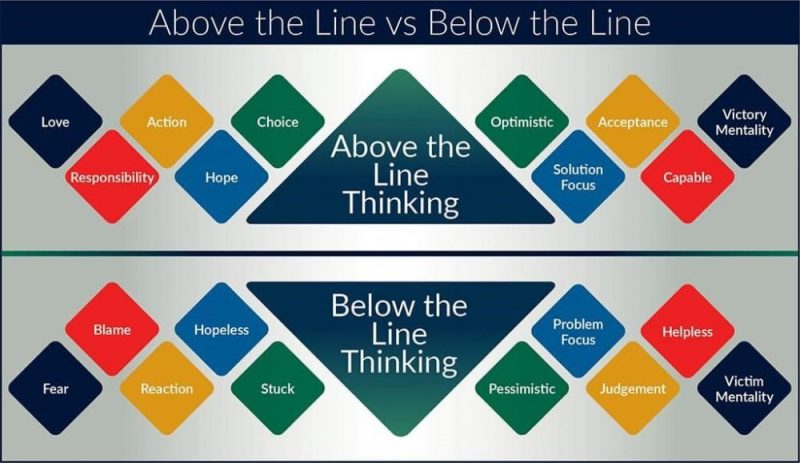
In these challenging days, it's easy to despair. Deborah Trengove explains how we can all embrace optimism, with 'above the line' thinking.
At the beginning of the recent mini-lockdown, I had an interesting exchange with a local dry-cleaner. We shared our mutual frustration with the lockdown, blamed the government, its protocols, the quarantine system, the slow arrival of a vaccine and finally, the virus itself. Then, we changed tack: we both agreed things could be worse, we would get through it and there were others worse off who we felt for. I left feeling encouraged and buoyed.
Above the Line vs Below the Line
This was an example of moving from below the line to above the line thinking. Below the line thinking is characterised by blaming, hopelessness and negativity. It leads to procrastination, self-doubt and worry. By contrast, above the line thinking is solution-focused and hopeful, building confidence, perspective and compassion.
When feeling disappointed, angry and frustrated, it is easy to engage in below the line thinking. Students who are disappointed in a test result might blame the teacher for not properly preparing them, that it was too hard or that they didn’t have enough time to study. Sometimes, there are genuine reasons for such complaints, but often these excuses protect young people from taking responsibility and using the experience to improve for next time. Below the line thinking can be seen in learned helplessness, in the idea that we can never do well, so there is no point even trying. Moving to above the line thinking helps us to identify practical strategies such as effective time management or trialing different study techniques, as well as using mistakes to promote learning.
We can all benefit from above the line thinking – young people and adults, sporting groups and executive teams.

Above the line thinking can be consciously nurtured by first allowing time for emotions to be acknowledged. It really was disappointing to be back in lockdown and it triggered worries about the future: will 2021 be like 2020 after all, will we ever get back to our ‘normal’ lives? Uncertainty can be challenging. Having plans disrupted and expectations thrown up in the air can be hard. However, when we move to above the line thinking, anxieties can be put in context, priorities re-set and we can focus on possibilities rather than losses.
'Realistic' optimism
Optimism is a critical element of above the line thinking and has considerable benefits for physical, emotional and social wellbeing. Optimism helps us to not only survive but to thrive. In 2011, Holocaust survivor, 109-year-old Alice Herz-Sommer, was asked about her secret of life. ‘Optimism’, she replied. ‘Life is beautiful. I know about the bad things but I look to the good. I see beauty everywhere.’ Such optimism is inspiring in the face of all Alice had experienced in her lifetime. Optimism sustained her and was the wellspring of her love for life.
Optimism builds resilience, hope and problem solving. Optimists are healthier, live longer and manage stress better. Optimism is positively related to social connectivity and life satisfaction. But being optimistic does not mean being a ‘Pollyanna’ – it is an approach to finding solutions, based on an accurate understanding of the current situation, its challenges and possibilities. Realistic optimism, therefore, seems to be most beneficial as it does not foster expectations for perfection, but is forward looking and practical.
Obstacles to optimism
Watch out for the triple Ps, described by Martin Seligman (University of Pennsylvania Positive Psychology Centre) as mental habits which undermine resilience and block optimistic thinking.
- Pervasive: a belief that when something goes wrong, everything is ruined.
- Permanent: thinking it will never get better, it never changes.
- Personal: I can’t do anything, I’m not good enough, it’s my fault.
If you recognise these traits in yourself or others, gently but persistently challenge them. They are habits of thinking which limit potential for growth and happiness. Ask ‘where is the evidence?’ to break down the underlying ‘all or nothing’ thinking and encourage self-talk which is Positive, Purposeful and has Perspective.
Building optimism in a time of uncertainty
There are close links between optimism and gratitude. Consciously looking for the positives, the small wins and joys in daily life helps us maintain perspective. Our natural tendency to pay attention to negativity, drama and danger may be hard-wired to protect us from harm, but it is important to balance this tendency with noticing what is good, enjoyable and successful in our everyday lives.
We also need to accept that there are things we cannot control and have the confidence to believe we can adapt to change, even if we would prefer not to have to. Being flexible and responsive to fluctuating circumstances is vital for young people in whatever the future holds for them. Much is learned when we work through challenges together, growing both as individuals and as a community.
It is important to acknowledge that practical, emotional or social difficulties can be experienced in times of change and uncertainty – and that it is OK to feel doubt, frustration and anxiety. These are normal responses which, when shared, can be processed and hopefully, alleviated with support and encouragement.
So, above the line or below the line? Optimism or despair? Let A. A. Milne have the final word.
‘It’s snowing still,’ said Eeyore gloomily.
‘So it is.’
‘And freezing.’
‘Is it?’
‘Yes,’ said Eeyore. ‘However,’ he said, brightening up a little, ‘we haven’t had an earthquake lately.’
– Winnie the Pooh

About the author
Dr Deborah Trengove is St Leonard’s College Director of Pastoral Care and Senior School Counsellor/ Psychologist.
You might also like her previous articles:
Lessons from Lockdown: The good things we’ve discovered
Ready for anything: Tips for the 2021 school year
Subscribe to The Parents Website

